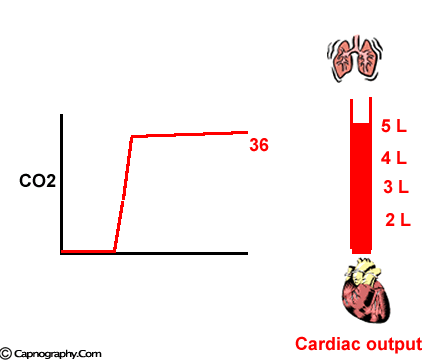Physiology of capnography
How does cardiac output affect PETCO2

Increases in cardiac output and pulmonary blood flow result in better perfusion of the alveoli and a rise in PETCO2.
Under conditions of constant lung ventilation, PETCO2 monitoring can be used as a monitor of pulmonary blood flow
Cardiac output and (a-ET)PCO2
Reduction in cardiac output and pulmonary blood flow result in a decrease in PETCO2 and an increase in (a-ET)PC02.1,2 The percent decrease in PETCO2 directly correlated with the percent decrease in cardiac output (slope= 0.33, r2=0.82 in 24 patients undergoing aortic aneurysm surgery with constant ventilation).3 Also, the percent decrease in CO2 elimination correlated with the percent decrease in cardiac output similarly (slope=0.33, r2=0.84).3 The changes in PETCTO2 and CO2 elimination following hemodynamic perturbation were parallel. These findings suggest that decrease in PETCO2 quantitatively reflect the decreases in CO2 elimination.3
Increases in cardiac output and pulmonary blood flow result in better perfusion of the alveoli and a rise in PETCO2.1,2 Consequently alveolar dead space is reduced as is (a-ET)C02 The decrease in (a-ET)PC02 is due to an increase in the alveolar C02 with a relatively unchanged arterial C02 concentration, suggesting better excretion of C02 into the lungs. The improved C02 excretion is due to better perfusion of upper parts of the lung.2 Relationship between PETCO2 and pulmonary artery blood flow was studied during separation from cardiopulmonary bypass.4 This showed that PETCO2 is a useful index of pulmonary blood flow. A PETCO2 greater than 30 mm Hg was invariably associated with a cardiac output more than 4 L/min or a cardiac index > 2 L/min.4 Furthermore, when PETCO2 exceeded 34 mm Hg, pulmonary blood flow was more than 5 L/min (CI > 2.5 L).4
Thus, under conditions of constant lung ventilation, PETCO2 monitoring can be used as a monitor of pulmonary blood flow.4-8
Recently, using Fick’s Principle, attempts were made to determine cardiac output non-invasively implementing periods of CO2 rebreathing during which CO2 partial pressure of oxygenated mixed venous blood was obtained from the measured exponential rise of the PET value. In addition, oxygen uptake, carbon dioxide elimination, end-tidal PCO2, oxygen saturation, and tidal volume were determined. The results are encouraging in patients with healthy lungs.9 Whereas the results are controversial when the lungs are diseased.10
References:
1. Leigh MD, Jones JC, Motley HL. The expired carbon dioxide as a continuous guide of the pulmonary and circulatory systems during anesthesia and surgery. J Thoracic cardiovasc surg 1961;41:597-610.
2. Askrog V. Changes in (a-A)CO2 difference and pulmonary artery pressure in anesthetized man. J Appl Physiol 1966;;21:1299-1305.
3 Shibutani K, Muraoka M, Shirasaki S, Kabul K, Sanchala VT, Gupte P. Do changes in end-tidal PCO2 quantitatively reflect changes in cardiac output? Anesth Analg 1994;79:829-33.
4. Maslow A, Stearns G, Bert A, Feng W, Price D, Schwartz C, Mackinnon S, Rotenberg F, Hopkins R, Cooper G, Singh A, Loring SH. Monitoring end-tidal carbon dioxide during weaning from cardiopulmonary bypass in patients without significant lung disease. Anesth Analg 2001;92:306-13.
5. Weil MH, Bisera J, Trevino RP, Rackow EC. Cardiac output and end-tidal carbon dioxide. Crit Care Med 1985;13:907-9.
6. Ornato JP, Garnett AR, Glauser FL. Relationship between cardiac output and the end-tidal carbon dioxide tension. Ann Emerg Med 1990;19:1104-6.
7. Jin X, Weil MH, Povoas H, Pernat A, Xie J, Bisera J. End-tidal carbon dioxide as a noninvasive indicator of cardiac index during circulatory shock. Crit care Med 2000;28:2415-9.
8. Isserles SA, Breen PH. Can changes in end-tidal PCO2 measure changes in cardiac output? Anesth Analg 1991;73:808-14.
9. Gedeon A, Krill P, Kristensen J, Gottlieb I. Noninvasive cardiac output determined with a new method based on gas exchange measurements and carbon dioxide rebreathing: A study in animals/pigs. J Clin Monit 1992;8:267-78.
10. Pianosi P, Hochman J. End-tidal estimates of arterial PCO2 for cardiac output measurements by CO2 rebreathing: a study in patients with cystic fibrosis and healthy controls. Pedatr Pulmonol 1996;22:154-60.

 Twitter
Twitter Youtube
Youtube









